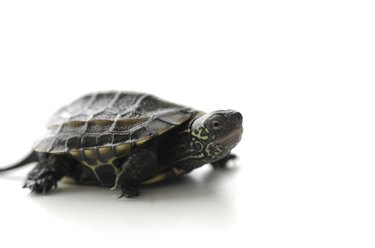Communication varies among different breeds of turtles, tortoises, and terrapins. These reptiles all have their own way of "talking" to each other as well as interacting with other species. Despite not having ears, some turtle breeds can be verbal, emitting sounds through their mouth when mating, but their primary mode of communication is through touch and body language.

Video of the Day
The way a pet turtle communicates varies from a turtle in the wild. Domesticated turtles need to interact with their human, so they develop different ways to interact in comparison to terrapins and tortoises, who live away from people. In addition, sea turtles and turtles that spend less time in the water also vary in how they articulate needs and feelings.
Video of the Day
Turtles are mostly independent
Turtles and tortoises tend to be more solitary beings. They don't spend much time with other turtles and don't gather in groups other than when they're nesting, migrating, or seeking a mate. For example, female sea turtles travel in a pack with the other female sea turtles. They go to the shore at night to lay and bury their eggs. Despite being around one another, they do not interact much. They do, however, have many symbiotic relationships with other sea creatures who depend on them for survival and travel with them across the sea.
When you have a turtle as a pet, it is likely that they will mostly keep to themselves, though they are believed to be happy having human company. When kept captive as pets, turtles require a lot of care and attention from their human to survive and thrive. They don't need to have more turtles around for company, but they do need their owner to care for them and spend time with them during their long life. Different types of turtles and tortoises have different needs to consider.
Turtle and tortoise body language
For all turtles, body language is a primary communication method. Since they don't have exterior ears, they rely a lot on tactile communication. They use their eyes to "listen" by taking cues and conversing through stances and different body positioning. Two giant tortoises staring each other down may appear to be observing one another, but they are actually having an argument that is just delivered visually instead of verbally.
Touch is also a big part of turtle and tortoise body language. A male turtle may touch a female turtle when trying to get to know her before mating. One of the first ways a male expresses interest and tries to get the attention of a potential mate is through fluttering, which is the act of shaking his claws in her face and around her head. He may also use his neck to nuzzle or may bite her to get her attention.
Communicating with sound
Turtles have interior ears but not outer ears. The exterior is covered with flaps that take in sound waves. Because of this, their hearing is better when in water, though the quality and strength of their hearing of vocal sounds is very low. The tremor and movement brought by sound are more of what a turtle experiences. Sea turtles, for example, react to low sounds and vibrations. So, while they don't use sound in the way humans do to communicate, it's a big part of their daily life and is sometimes used to interact with one another.
In addition to hearing, turtles do make some noises of their own. They can also sing, growl, whistle, cry, and grunt. Sounds can happen when they are feeling protective. A mother turtle may make noise when she is nesting. A turtle that feels threatened may hiss. Baby turtles even begin to making harmonic sounds before they are born. They also have vocal mating calls.
- South American Vacations: Galapagos Giant Tortoise: 23 Interesting Facts
- Sea World: Sea Turtles - Senses
- All Turtles: Do Turtles Have Ears?
- North Carolina Aquarium at Fort Fisher: Mating and Dating in the World of Turtles
- San Diego Zoo: Turtle and Tortoise
- Sea Turtle Conservancy: Information About Sea Turtles: General Behavior
- Olive Ridley Project: Sea Turtle Hitchhikers - The Symbiotic Relationships of Sea Turtles
- Everyday Health: Everything You Need To Know About Raising Pet Turtles
- Urban Fishkeeping: Do Turtles Make Noise? What Sound Does A Turtle Make?